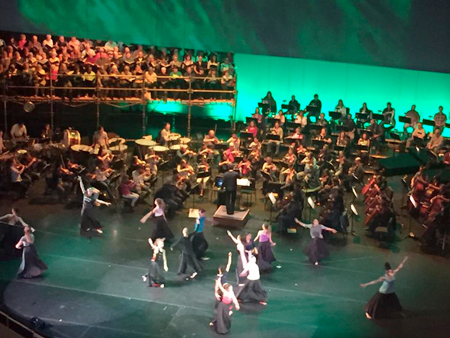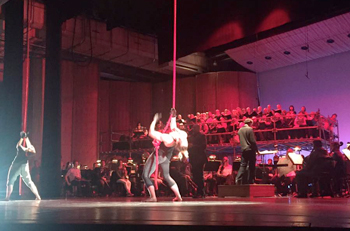by Daniel Hathaway

The setup was as clever as the whole concept of the production. To provide enough elbow room for a large company of dancers to move freely, the orchestra, with its two pianos and abundant percussion, was moved upstage. The Akron Symphony Chorus had a fine view of the proceedings from its own balcony. The three soloists were incorporated into the choreography — Kahl, brilliant in her white and gold costume, acting the part of the goddess Fortuna in the opening and closing scenes. When the children’s chorus made their appearance later in the piece, Shimotakahara worked them into the action, eventually creating a grand spectacle at the end.
Not just a choral performance with some dancing added, this Carmina Burana was choreographed from beginning to end. Most of the leg work went to GroundWorks’ core dancers and some added guests. Costumed in red tops and long red skirts with black lining, the dancers made imaginative use of their vestments to change color schemes, create swirling effects, and at one point, to morph into perfectly spaced red pods at the end of a section. Two dangling ropes provided the props for a sensual accompaniment to one steamy song, and at another point, four double-stacked male dancers created a hilarious moment of comedy.
Baritone Brian Keith Johnson splendidly articulated the Latin patter song “Estuans interius,” amusingly conjured up the drunken Abbot of Cockaigne, and sang his lines in the Court of Love with focused sonority. Tenor Timothy Culver sang the lament of the spit-roasted swan with anguished feeling, returning later for a more flattering cameo solo. Soprano Grace Kahl, mute until the third section of the piece, was rapturous in her solos, especially when she floated up to a stratospheric note in “Dulcissime.”
The subtly amplified Akron Symphony Chorus, prepared by Marie Sensi Sellner, sang themselves proud throughout the work. Though the men’s “Wafna’s” in the Abbot’s song were covered by the orchestra, they did a masterful job with the tricky a cappella number “Si puer cum puellula.”
Trained by Ann Usher, the Cleveland Orchestra Children’s Chorus added beautifully-sung innocence to their parts in “The Court of Love,” as well as some well-regimented movement involving Kahl and the dancers.
Music Director Christopher Wilkins led a briskly-paced performance, deftly coordinating his fleet of musicians — many of whom had their backs to the podium most of the time.
But the principal bow goes to David Shimotakahara, who marshalled multiple dancers (both professional and amateur), soloists, and the children’s chorus into a well-integrated whole, giving everyone meaningful things to do. And the expressive unison movements he assigned to the more experienced dancers were executed with precision.
The capacity audience loved this production, as well they should. The ovation was tremendous, and even the curtain calls were perfectly choreographed.
Though this program hardly needed another piece, Wilkins led the orchestra in Leonard Bernstein’s On the Waterfront Symphonic Suite to begin the evening. The composer seemed proud enough of his 1954 score to the famous Marlon Brando film to want to present the music without subordination to visual images, hence the symphonic suite.
Bernstein might have overestimated the ability of the score to stand on its own, and a lot of it sounds derivative (Copland is lurking in the background). The orchestra played it with commitment and style, and Meghan Guegold’s opening and offstage horn solos were ravishing. But was it really worth the extra stage shift?
Published on ClevelandClassical.com May 17, 2016.
Click here for a printable copy of this article





